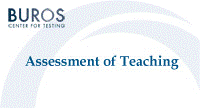Buros-Nebraska Series on Measurement and Testing

Assessment of Teaching: Purposes, Practices, and Implications for the Profession
Date of this Version
1990
Document Type
Article
Citation
From: Assessment of Teaching: Purposes, Practices, and Implications for the Profession, edited by James Y. Mitchell, Jr., Steven L. Wise, and Barbara S. Plake; Series Editor Jane Close Conoley (Hillsdale, New Jersey, Hove & London: Lawrence Erlbaum Associates, 1990)
Abstract
This chapter discusses some of the types of evidences that are appropriate for assessing the quality of teacher-licensure tests. Licensure tests are used to make dichotomous decisions, so reliability estimates of the consistency of decisions are needed. Because the inference of interest has to do with the minimum competency necessary to prevent harm from coming to the clients, it is argued that content validity is the type of validity evidence most appropriate for licensure tests. However, evidences for criterion-related validity, construct validity and "curricular validity" are also discussed. The issue of whether the cut score on a licensure test should in any way be related to the supply and demand and the requirements for reporting test scores and documenting the quality of the test are also discussed.
It is concluded that teacher-licensure tests allow valid inferences for a delimited set of inferences. An effective teacher-licensure test will not eliminate the need for subsequent teacher evaluation; it will not cure all educational ills; and it will not eliminate all ineffective teachers. Nevertheless, it should help ensure that those individuals who are licensed have a minimal level of competence on some important sub domains of knowledge and skills relevant to their profession.
ASSESSING THE QUALITY OF TEACHER ASSESSMENT TESTS
Scott wontpass in his assignment at all, he had a poem to learn and he fell tu do it. (Time, 1980)
If selection of the most suitable people to be teachers is a matter of importance to the five percent of the population who become teachers, it is no less important a matter to the 100 percent who become students. (Pratt, 1977, p . 16)
If education is the cornerstone upon which a great nation builds, then teaching is our most important human activity. (Sweeney & Manatt, 1986, p. 446)
It seems so obvious. Quality education is important to the nation. Quality teachers are important for quality education. But historically not all who received licenses to teach were of high quality-or necessarily even competent. We do not want incompetent teachers. Licensure tests are used in over 900 other occupations in an effort to protect the public, and in those occupations the public typically has a choice of whom to go to for services. Teachers have conscripted clients. Licensure tests should be able to weed out prospective teachers with skills at a level such as that demonstrated in the first of the preceding quotations. Isn't it obvious licensure tests should be useful in a profession as important as teaching?
But things are not always as obvious as they seem. What is "teacher competency?" How do we know whether tests really measure it? Such questions should be, and have been, asked. This chapter is intended to take a close look at several issues regarding the quality of teacher-competency tests. A general conclusion of the paper is that if such tests are constructed properly they will be of sufficiently high quality to be valid for a delimited set of inferences.
Included in
Educational Administration and Supervision Commons, Educational Assessment, Evaluation, and Research Commons


Comments
Copyright © 1990 by Lawrence Erlbaum Associates, Inc. Digital Edition Copyright © 2012 Buros Center for Testing. This book may be downloaded, saved, and printed by an individual for their own use. No part of this book may be re-published, re-posted, or redistributed without written permission of the holder of copyright.